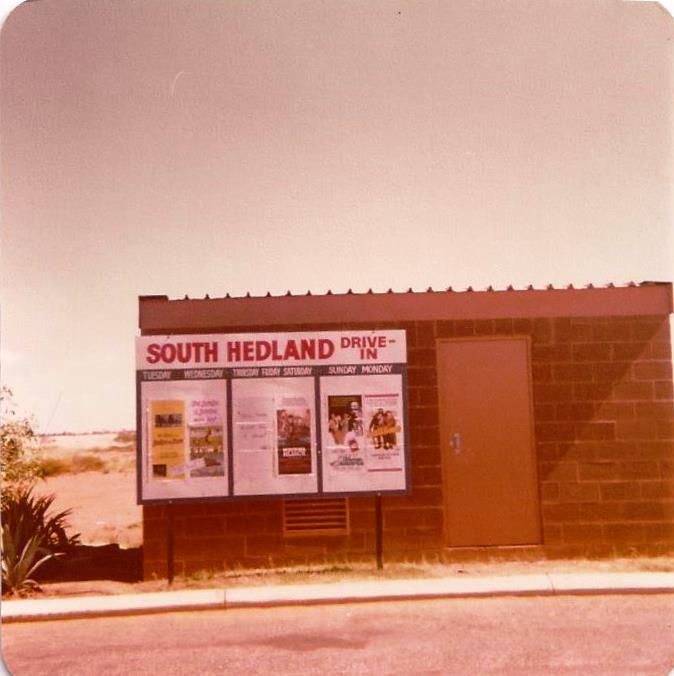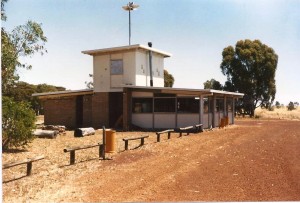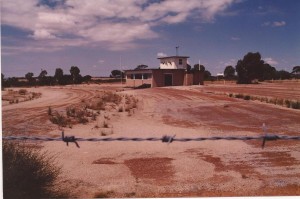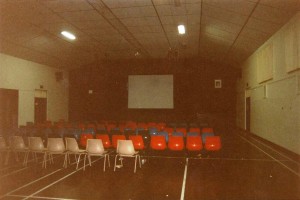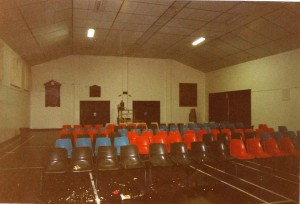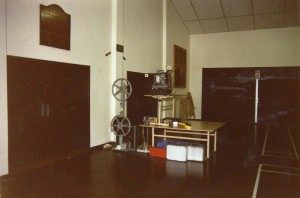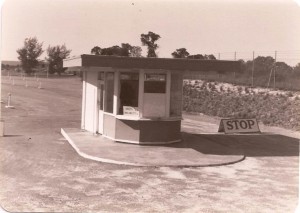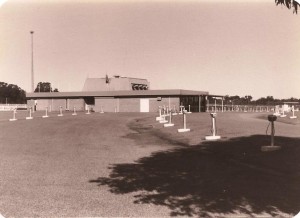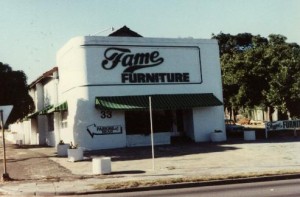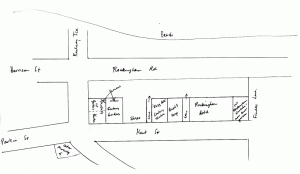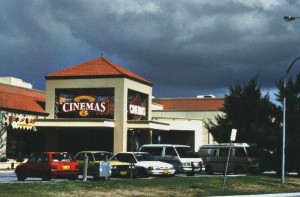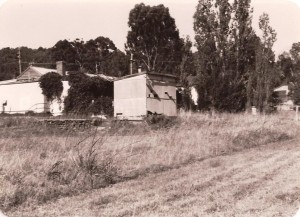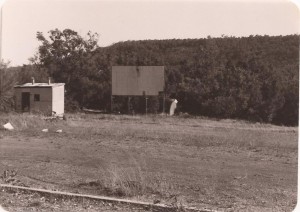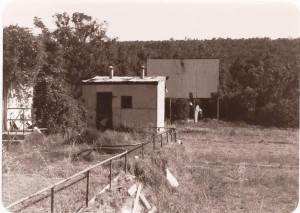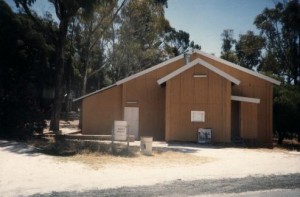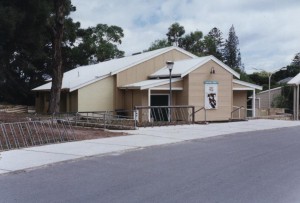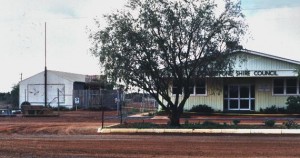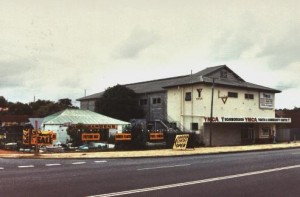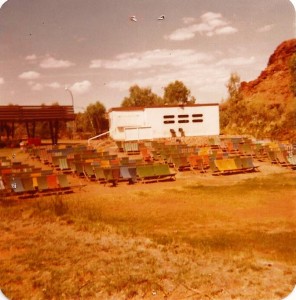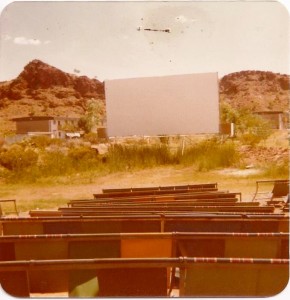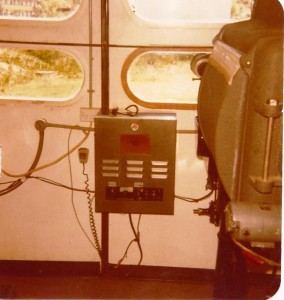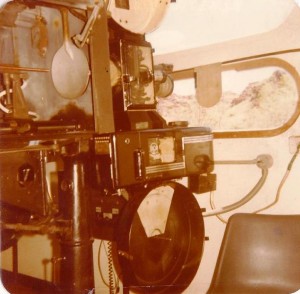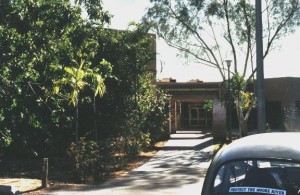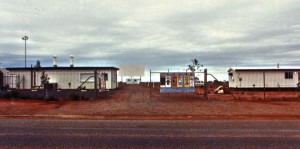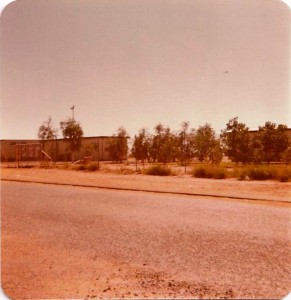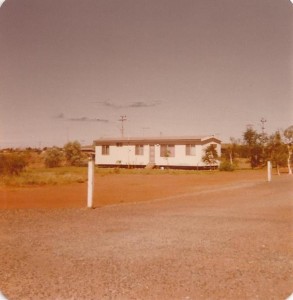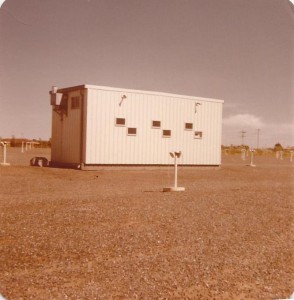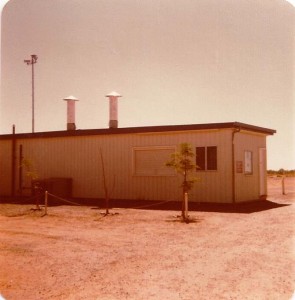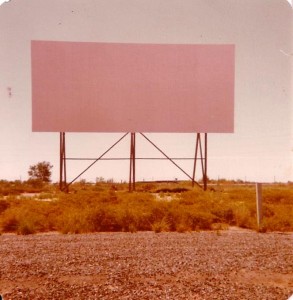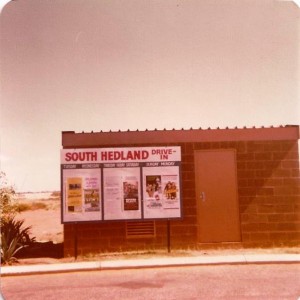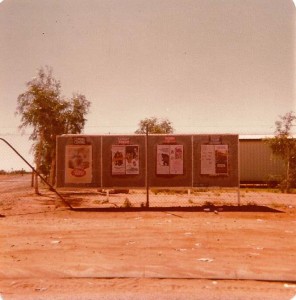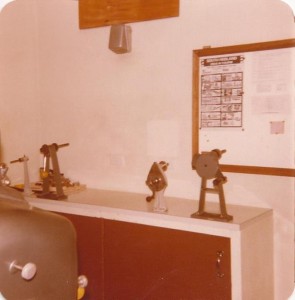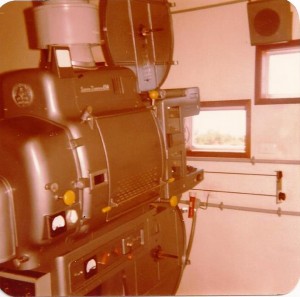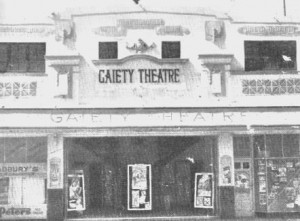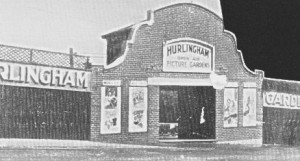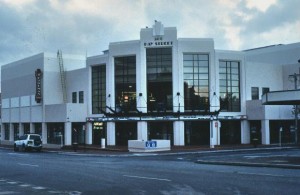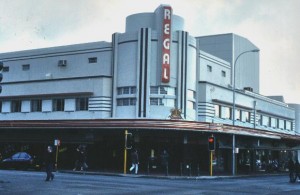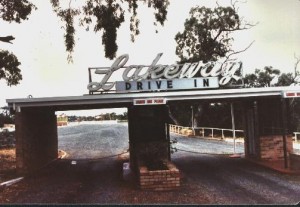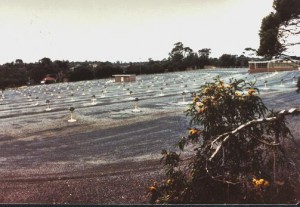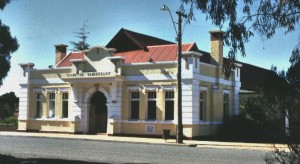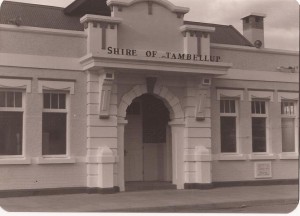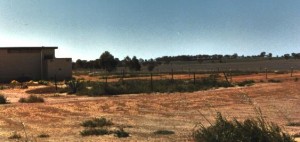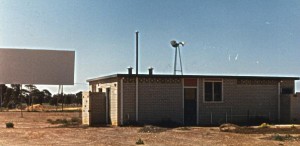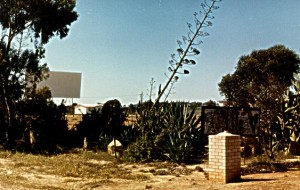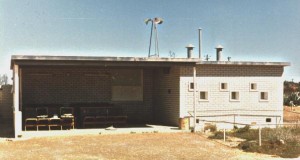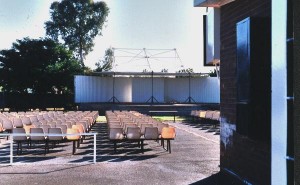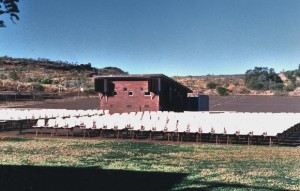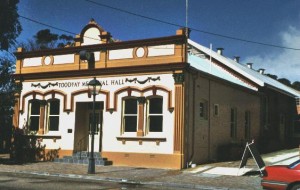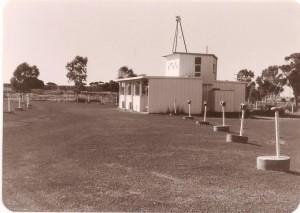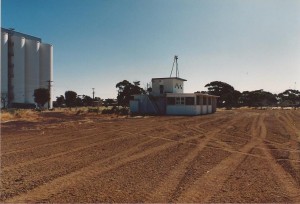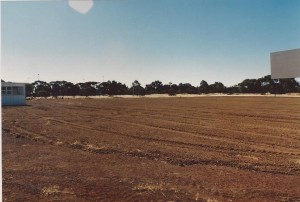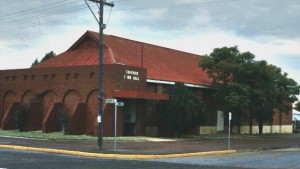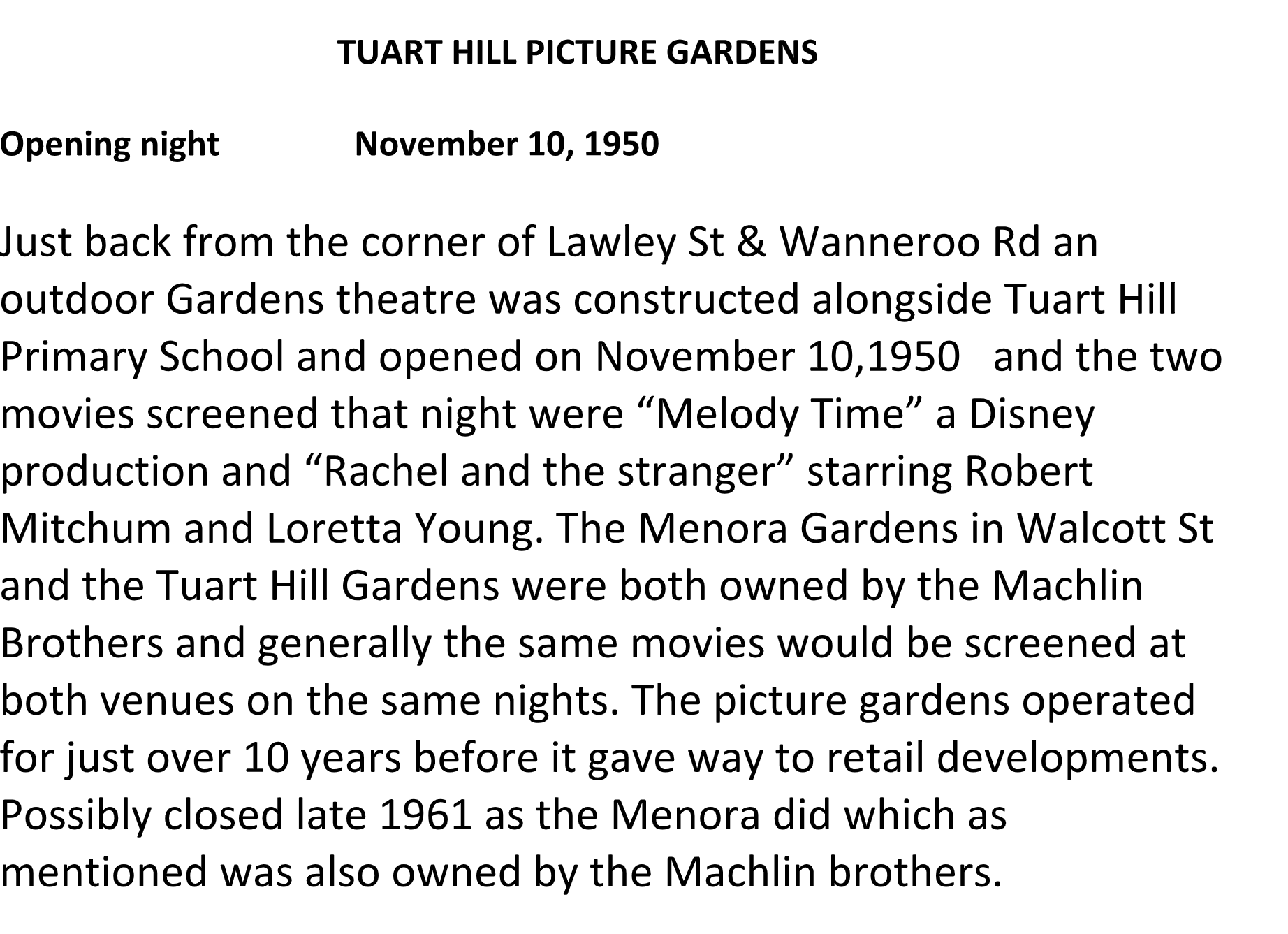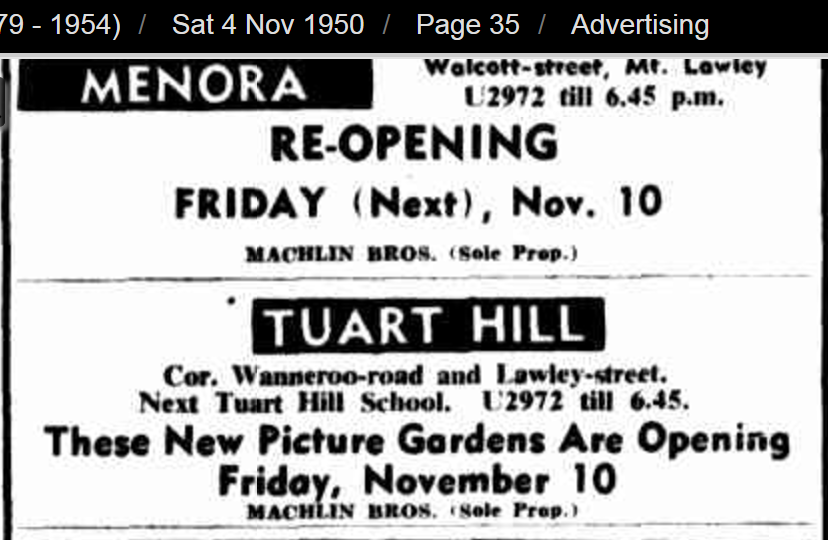Quicklinks
QUAIRADING
QUAIRADING DRIVE-IN, Louden St, Quairading
Paddy Baker opened this drive-in for 130 cars in 1966, on the north-east corner of the junction of Louden St and Jennaberring Rd. It was still functioning in 1986, and it is not clear when it closed, but in 1997 it was just a bio-box in a paddock.
Sources: Film Weekly Directory 1968/9 – 1971
Public Health Department, building permit, Battye 1459
Max Bell, Perth – a cinema history, The Book Guild, Sussex, 1986, p.140
Max Bell, Kino, no.15, March 1986, p.22
Interview (Peter Morris): Paddy Baker (1978)
Photos; 1 exterior, colour, 1980’s ,Max Bell
1 exterior, colour, 1996, Roy Mudge
SHIRE HALL, McLennon St, Quairading
The Quairading Shire Hall is constructed with the old facade addressing McLennan St, on the east side of the junction with Heal St. The Municipal Heritage Inventory describes it like this:
Prior to the Roads Board office being constructed on this site, in 1915 an office was situated at Lot 16 Heal St. When the new offices were constructed on this site, the previous building was incorporated into the new building. The original Roads board office on this site is a brick structure with a hipped corrugated iron roof which is partly concealed behind the parapet walls. The facade of that building is part of the 1934 refurbishment and introduces the art deco geometric design treatment of the face brickwork a a feature against the cream rendered walls. The brickwork also shows the influence of the Arts and Crafts movement. The facade is symmetrically proportioned with a centrepiece window design, and double entry doors both sides with a stepped parapet above the entire centre. The hall has external stack bond pier structural elements, and a gabled roof of corrugated iron. The 1979 extension was extensive. A new kitchen, bar area and function rooms were added to the south side, and an expansive entry foyer opening to the east was also added. The 1979 section has a relatively flat roof concealed behind a colourbond facia. A succession of developments on the site each complement the previous architecture and design, and respect the previous fabric.
Quairading Shire Hall was on Hazell’s circuit, which was taken over by Paddy Baker, who continued here until after he opened the drive-in in 1966. The alterations reversed the aspect of the hall, locating the new entrance where the old stage was and a new stage where the entrance had been. While the 1979 alterations were being done, a large amount of money was found in a drainpipe, and was widely assumed to have been left there by Baker.
Sources: Film Weekly Directory 1940/41 – 1967/8
Shire of Quairading, Municipal Heritage Inventory, no.1
Post Office Directory 1940/41-1944
Interview (Peter Morris): Paddy Baker (1978)
Photo: 1 exterior, b&w, n.d., Shire of Quairading, Municipal Heritage Inventory, no.1
1 exterior, colour, 1997, Graeme Bertrand
3 interior, colour, 1996, Roy Mudge
QUEENS PARK
QUEENS PARK HALL AND GARDENS, Queens Park
Queens Park Memorial Hall was built in 1923, as a memorial to the veterans of World War 1. This hall, containing 250 seats, was another of the venues belonging to the southern circuit operated in the forties by R.R.Perrie. A gardens was added in the fifties, and the venue ceased operation as a cinema in 1966.
Sources: F.G.Carden, Along the Canning: a history of the Shire of Canning district, WA, Shire of Canning 1968
Film Weekly Directory, 1940/41 – 1960/61
West Australian, 1954 – 1966
Photo: F.G.Carden, Along the Canning: a history of the Shire of Canning district, WA, Shire of Canning 1968, opp.p.112
QUININUP
HALL, Quininup
The town is listed in the Film Weekly Directory as being on Allan Jones’ circuit from 1951/2 to 1961/2.
Sources: Film Weekly Directory 1951/2 – 1961/2
RAVENSTHORPE
MECHANICS INSTITUTE HALL, Floater St, Ravensthorpe
The Mechanics Institute was built in 1907 on the south-west corner of the intersection of Floater and Morgan Sts. It was a timber-framed, iron-clad building, with a brick facade. It was used for various community activities, including roller skating, meetings, a public library, concerts and musical evenings.
By 1909, moving pictures had been screened there, but it is not clear who conducted these shows or how often they were held. In the forties, weekly screenings in the Mechanics Institute were conducted by Mrs E.M.Daw.
In 1954, extensive renovations were carried out: the building was restumped, lined, the internal biobox was relocated to the outside and the front of the hall repaired. In the late sixties, the Parents and Citizens Association was listed as the exhibitor there.
In the eighties, Frank Terry toured sometimes through here, with Lyn Parker. The best show on this circuit was in Ravensthorpe – 240 people came to see The Man from Snowy River. So Parker decided that Ravensthorpe was a good place to try a permanent show again. About 1988 he screened occasionally in Ravensthorpe hall – about six or eight films over a two-year period, using his own projection equipment (even though the projectors were still in the hall).
In 1986 the building was sold and demolished: Rangeview Park now stands on the site. In the plans under consideration in 1997 for a new entertainment centre in the town, no provision was made for a bio-box and film screenings were not envisaged.
Sources: Film Weekly Directory 1940/41 – 1945/6, 1968/9 – 1971
Shire of Ravensthorpe, Municipal Heritage Inventory, Place no.67
Photo: 1 exterior, b&w, 1930, A.W.Archer, Ravensthorpe then and now, publisher not given, 1976, p.85
1 exterior, b&w, m.d., Shire of Ravensthorpe, Municipal Heritage Inventory, Place no.67
RAWLINNA
OLD SCHOOL HOUSE, Rawlinna
Rawlinna is a tiny settlement in the middle of the Nullarbor, about halfway between Kalgoorlie and the South Australian border. Its population is mainly railway families, tending the transcontinental line. From 1966 to the late seventies, 16mm films were screened fortnightly in the schoolhouse, organised by the schoolmaster in co-operation with Lindsay Morris, who worked for the PMG.
The modern schoolroom was flimsy, hot in summer and cold in winter, with many large windows, so difficult to black-out. It had to be set up for each screening, then put back into order to become the schoolroom for the next day. But the old school hall was clearly a more suitable venue: it was more solidly built so less susceptible to variations in the weather, and had fewer windows so could be more easily blacked out. It could be left ready curtained, and with the 85 to one hundred chairs left in place. Most important of all, it contained a large pot belly stove which could be fed with half a railway sleeper in the freezing cold of the desert evenings.
So, after only a few months, the screenings moved to this location. A biobox was built in on the verandah, with the one Bell and Howell projector belonging to the school permanently installed: there was considered to be no need for two projectors when that one could be re-threaded in three seconds! A porthole was built into the wall of the cloakroom so that refreshments could be served into the hall at interval. When the teacher wished to show films during classtime, the school pupils filed over to the older building, and regular screenings were also held for the general population, including those living on the station properties round about. Morris was the projectionist for the few years he remained in the town, organising film supply from Perth.
He tells the story of one occasion when two trains were parked in the station because of a derailment along the track. The passengers were cold and tired and bored, but that week’s film had already been shown and had been booked in at the railway station for return to the Perth supplier. The station master became so irritated by constant complaints from frustrated passengers that he brought the film over to the schoolhouse and begged Morris to screen it to keep the passengers happy, so it was screened three times that night before going back to Perth when the trains moved on.
Regular screenings continued until the late seventies or early eighties, when the railway houses were provided with access to satellite television. The building survived till its roof was ripped off in a cyclone in 1988.
Sources: Interview (Ina Bertrand): Lindsay Morris (1997/8
REDCLIFFE
REDCLIFFE GARDENS, Great Eastern Highway, Redcliffe
This simple open-air picture theatre advertised intermittently in the fifties and sixties. It was located on the northern side of Great Eastern Highway, between Lyall and Davis Sts, next to the Scout Hall. It seems to have been operated by C. Fitzgerald, who also operated the Belvedere Gardens in Belmont.
Sources: Max Bell, Perth – a cinema history, The Book Guild, Lewes, Sussex, p.63
Film Weekly Directory, 1954/5 – 1958/9, 1960/61 – 1961/2
West Australian, 1954 -5, 1960-62
REEDY
OPEN AIR THEATRE, Shugrue St, Reedy
The Reedy (or Reedys) Mine is about sixty kilometres north-east of Cue. It opened around 1934, and a thriving community of mine workers and their families grew up in the nearby township of Reedy. The hall and open air picture theatre was built on Lot 57 of the town plan, between Chisson and Vale Sts. In the forties, the picture show was run by members of the Briggs family. The mine closed for a short while during World War 2, and was never again as prosperous as before the war: it closed again in 1955, and the township gradually disappeared. In 1997, Reedys Mine was again working, but the town never revived, and there was no trace of where the cinema might have been.
Sources: Film Weekly Directory 1940/41, 1942/3-1943/4, 1948/9
Post Office Directory 1947, 1949
P.R.Heydon, Just a century ago: a history of the Shire of Cue, Hesperian Press, Victoria Park, 1987
Town plan marked with location (on wall of Cue Tourist Office, too faint to copy)
RIVERTON
RIVERLINE DRIVE-IN THEATRE, High Rd, Riverton
This drive-in was built for City Theatres, as the fourth of the ‘Line’ drive-ins, and the 15th in the suburban area, and was designed by Arthur Leith.
It opened on 1 April 1969:
The 500-car drive-in has a central operational building including concession snack bar, dinette and toilets at ground level and a spacious bio-box above.
A playground with suitable equipment will be installed immediately behind the concession building for the convenience of children attending the drive-in. The site will be developed with suitable shrubs and trees to fit into the present landscape.
Excellent screen results are visible on the 90ft screen from the projection and sound equipment supplied by National Theatre Supply Co, which includes 70/35mm. Cinemacanica projectors with Superzenith arcs, and a third 35mm. super standard projector. (Australasian Exhibitor, 24 April, 1969)
This was the first drive-in able to present 70mm, so there was a backlog of 70mm films that had not been screened in drive-ins. The company ran these for several months, with so much success that the back ramps, which had been formed for later expansion, were almost immediately provided with sound speakers, increasing the capacity to 705.
In 1988, Hoyts took over City Theatres and immediately closed all six drive-ins: the Riverline was then sold for $750,000, and the site developed as a housing estate.
Sources: Public Health Department, building permit, Battye 1459
Max Bell, Perth – a cinema history, The Book Guild, Lewes, Sussex, p.128
Australasian Exhibitor, 23 May 1968, p.5; 24 April 1969
Film Weekly, 1 February 1968, p.1; 1 May 1969, p.2
Film Weekly Directory, 1968/9 – 1971
Kino, no.25, September 1988, p.23
West Austrlaian, 1969 – 1988
Interviews (Ina Bertrand): Alan Crew (1997), Arthur Stiles (1985)
Photos: 1 exterior, b&w, Australasian Exhibitor, 23 May 1968, p.5; 24 April 1969
RIVERTON PICTURES, Riverton
A picture business was listed in the Riverton Hall around 1958 to 1961, but it is not clear where this operated or who was involved.
Sources: Film Weekly Directory, 1958/9, 1960/61
RIVERVALE
ASCOT AND GARDENS, 33 Great Eastern Highway, Rivervale
Riversdale Public Hall was opened on 22 February 1919. In 1935 Guildford Rd was renamed Great Eastern Highway: before that, that section of Guildford Rd from Belmont Ave to the railway line was known as Ascot Rd, and this is the section (between Norwood and Surrey Sts) in which the Riversdale hall was built, which might confirm that it was called the Ascot theatre. The local community (the Riversdale Progress Association, led by the Newey family) raised all the funds for the hall and were actively seeking to have the district named Riversdale, but were unsuccessful: the compromise was Rivervale, and the locals called the hall the Rivervale Theatre.
Films were shown there from very early (perhaps even from the beginning) and the Belmont Historical Society has photos of the hall with film posters displayed outside, even before the bio-box was built above the porch.
However, the local committee running the hall ran into debt and the hall was sold and used for various purposes, including as a billiard saloon. It reverted to use as a picture theatre after World War 2.
The original hall held only 250, and a gardens holding 300-350 was built alongside in about 1948, with a corrugated iron fence and canvas deckchairs: in 1958 it was enlarged to hold 350, and a new facade built.
The theatre and gardens were operated by R.R.Perrie, who had a circuit in the southern suburbs, taking in Armadale, Gosnells, Queens Park and Bayswater as well as Rivervale.
The theatre survived the early years of television, but closed in 1966. The building was used for offices, and later as a warehouse, and in the nineties was still there, but difficult to recognise as a former cinema: it was used as commercial premises.
Sources: Shire of Belmont, Historical Inventory, pp.66-69
Max Bell, Perth – a cinema history, The Book Guild, Lewes, Sussex, 1986, pp.19, 55
Film Weekly Directory, 1945/6 – 1966/7
Post OFfice Directory, 1946 – 1949
West Australian, 1951 – 1966
Conversation with Ann Spalding, Belmont Historical Society, 9 August 1997
Photos: 1 exterior, colour, 1981 (Bill Turner)
3 exteriors, b&w, (one of opening ceremony, one before bio-box was built, one after bio-box), various dates, Belmont Historical Society
1 exterior, colour, 1996, City of Belmont, Municipal Inventory, p.66
ROCKINGHAM
MELODY HALL & GARDENS, Kent St, Rockingham
Fronting on Kent St, on the corner of Railway Tce, the Melody Theatre was built with 450 seats, and a 350-seat gardens behind (along Railway Tce), for Sylvia Pell. Bill Ray was electrical contractor on the job, and married Sylvia Pell soon after. The theatre opened first (in 1955), then the gardens, even though by now the Century Gardens was open next door. The two open-air shows shared a fence, their screens only feet away from each other: the sound from one could be clearly heard in the other – a state of affairs which would only be tolerated in the boom days of the fifties. On one memorable occasion, the Melody was showing Captain Horatio Hornblower and the Century had a love story. Each put up the sound to try to drown out the other. From the Century came the dialogue: ´What can I do to prove that I love you?’ From the Melody came the reply: ´Give her a broadside!’
The second Melody Gardens was built by Bill Ray and Les Westley, diagonally across the road – a larger premises which could hold 5-600, with a brick screen that covered the whole of the back of the block. The theatre and gardens continued for some time after the drive-in was built: Lindsay Morris remembers switching between the two venues when he was projectionist there in 1961-3. The gardens closed in 1963-4, and the theatre in 1967: the theatre was gutted, and a new front was built for the shops which then occupied the site, but the exterior walls of the theatre building were incorporated into the new development.
Sources: Max Bell, Perth: a cinema history, The Book Guild, Lewes, 1986 pp. 34, 60, 115-6
Daily News, 23 Mar. 1997
West Australian 1961 – 1962
Interviews (Ina Bertrand): Jack Bidstrup (1985), Lindsay Morris (1997)
Photo: Daily News, 23 Mar. 1997
ROCKINGHAM 3 CINEMAS/ ROCKINGHAM 6 CINEMAS, Leghorn St, Rockingham
A triple cinema was opened in November 1981, on the south side of Leghorn St and opposite the intersection of Success Drive, operated by Coastal Cinemas. That first summer was also the trial of daylight saving in the state, and the cinemas suffered from this, but after the referendum Western Australia dropped ´summer time’ and the cinemas went on to be very successful indeed. They were operated in conjunction with Coastal Cinemas’ Fremantle venues, and screening the same product. Another three screens were added, opening 28 September 1995.
Hoyts took over the venue on 21 December 2001, along with the rest of Coastal Cinemas’ screens (in Fremantle).
Sources: Kino, no.39, March 1992 p.25; no.40, June 1992, p.26; no.43, March 1993, p.31; no.53, September 1995, p.31; no.54, December 1995, p.35; no.75, Autumn 2001, p.35.
West Australian 1991 – 2000
Interview (Margaret Howroyd): Peter Thomson (1994)
Interview (Ina Bertrand): Peter Thomson (1997)
Photos: 1 exterior, colour, 1997, Graeme Bertrand
ROCKINGHAM HALL & GARDENS/ CENTURY & GARDENS, Kent St, Rockingham
When Reg Grigg, owner of the Rockingham Hotel, went to World War 2 he leased the hotel to a group of people who had been involved in the film business in Perth, including L. A. Brewer. This group replaced the tennis courts beside the hotel (next to Flinders Lane) with an open air picture show seating about 350. The small hall attached to the hotel, known as the ´Jazz Hall’ because it had been used as a dance hall and fun parlour (it still had the crazy mirrors around the walls), was operated with the gardens as Rockingham Hall and Gardens.
At the expiry of the lease (some time after the end of the war), Grigg resumed the premises, continued to operate the hall but replaced the picture gardens with a beer garden, and shifted the open-air screen further up Kent St, towards Railway Tce and next to the new Melody Theatre. He renamed the show the Century Theatre and Gardens. It was a simple ´gardens’ seating 6-700, with toilets on either side of the screen, at the far end of the site from the entrance, and three blocks of seating – two of deck chairs and one of metal-framed wooden benches with wooden backs. The cement walls were painted green and yellow, and trees were planted near the toilet entrances. There was a small shop for selling sweets and drinks. A feature was a private ´box’ (a railed area with comfortable seating) for the Grigg family, located next to the bio-box at the rear. In the fifties, films were screened in the gardens seven nights a week from Christmas to Easter, and one or two nights a week for the rest of the year. Jack Bidstrup operated the show in unofficial partnership with Grigg, moving the projection equipment up and down the street from the gardens to the hall, depending on which one was in operation that night. There were only three or four occasions when the Century Gardens was full to capacity, so the seating was never increased. The shared boundary with the first Melody gardens was a continuing problem, till the Melody built new gardens on the opposite corner.
The Century and Gardens closed in 1963, and no trace remained of them in the nineties.
Sources: Max Bell, Perth: a cinema history, The Book Guild, Lewes, 1986 pp. 65, 104-5
Nora Taggart, Rockingham looks back: a history of the Rockingham District 1829-1982, Rockingham District Historical Society 1984
Interview (Ina Bertrand): Jack Bidstrup (1985)
ROEBOURNE
ROEBOURNE OPEN AIR PICTURES, Sholl St, Roebourne
The first settlers in the Roebourne district arrived in 1863 and the town of Roebourne was gazetted in 1866. This makes it one of the oldest surviving settlements, but it has never been a large town and is now overshadowed by other towns in the Pilbara, like Karratha (which became the administrative centre for the Shire of Roebourne in 1975). Roebourne is on the coast, but was never an important port: it was served first by Cossack and later by Point Samson. Rather it is a pastoral and mining centre, servicing a large surrounding area.
In the fifties, Mr Tsakalos owned a blue asbestos trucking business, the butcher shop, the open air picture show and one of the town’s three stores. The picture show was located on the north side of Sholl St, between Padbury and Withnell Sts. On the road frontage patrons entered a passage between the bio-box on the right and the ticket box on the left, built into the concession building which opened into the theatre area. The front wall was of corrugated iron, the other walls of wire mesh. The firm gravel floor sloped down from the entrance, with the whites and town aboriginal people sitting in the back rows on metal-frame sling seats, and the aboriginal people from the Reserve in the front rows on metal seats.
The venue opened on Wednesdays and Saturdays in the fifties all through the year, unless there had been rain and the seats were wet. Even in cold weather, it was always packed, with patrons bringing two rugs – one to sit on and one to cover their laps.
This was what Maureen Whitby calls ´a more innocent time’: young people were not allowed into the hotel, so the picture show was their main social meeting place, ´the only place your old man could take you when you were courting’. She remembers that ´All the noisy buggers sat on that side [the left facing the screen], Mums and dads in the middle, and the smoochers on the other side. You knew you were serious when you moved over to the smoochers’ side.’ She remembers the serials Jungle Jim and Tarzan, and the frustration of finding that episodes of these were missing from the schedule.
It was functioning before 1956, but the exact date is not clear. It closed in 1970, and for a short while films were screened on Yandina flat, near the Old People’s Home, but the floor there was dusty and the wind always blew sand in people’s faces, so attendance dropped off and it soon closed. In 1997, nothing remained of the Sholl St premises, which was then the site for a transportable house, next to the Veterinary Surgeon.
Sources: Informant: Maureen Whitby (1997)
ROLEYSTONE
PANORAMA DRIVE-IN THEATRE, Soldiers Rd, Roleystone
In 1956 Colin Hatfield closed the Roleystone Gardens and replaced it with a drive-in, opened about Easter on the south-west corner of the intersection of Soldiers Rd with the Brookton Highway. There was a small shop on the corner of the ten-acre block, which he adapted for use as an enclosed sit-in area, with comfortable seats like any theatre, but looking out through plate glass windows onto the huge drive-in screen. This sit-in area held 150 people, but he also built an open air section beside the house, which held a further 3-400. There was space for about one hundred cars in the drive-in section, though at first more could be squeezed in because for eighteen months sound was broadcast from loudspeakers, until he had time and capital to instal individual car speakers.
The venue was extremely successful, while drive-ins were a novelty and he could obtain product very quickly after city release because he was outside the twenty mile protection zone. It survived the arrival of television, but soon after that attendances began to decline, so he closed in April 1967, and the projection equipment was used to start up the Exmouth drive-in.
In 1997, the building used for the sit-in area was an antique shop, a real estate agent had premises on the site and the rest of the site was vacant.
Sources: Film Weekly Directory 1955/6 – 1966/7
Max Bell, Perth – a cinema history, The Book Guild, Lewes, Sussex, p.128
Daphne Popham, First stage south: a history of the Armadale-Kelmscott district, Town of Armadale 1980, p.149
West Australian, 18 April 1957, 1959 – 1966
Interview (Ina Bertrand): Colin Hatfield (1997)
Photos; 2 sepia, exterior , 1980’s Max Bell
ROLEYSTONE HALL AND GARDENS, Brookton Hwy, Roleystone
The Roleystone Hall was built in about 1922, north of the Brookton Highway, opposite the intersection with Croydon Rd. It was a small timber hall, with a corrugated iron roof, set back from the road and running parallel with it. It was constructed under the auspices of the Roleystone Progress Association, and only later passed over to the municipality.
On Saturday nights from 28 August 1948, Colin Hatfield exhibited in this hall, his first program being the double feature Miracle on 34th Street and Trail Street. Hatfield built a bio-box on the outside of the front wall, and the venue was so popular that on many occasions it was packed out – filling aisles, and squeezing in chairs wherever they would fit.
After only one summer season it became obvious that a less crowded venue was necessary during warmer weather, so Hatfield obtained permission from the Council to build an open air theatre, at right angles and to the east of the hall, taking up some of the parking space. This enabled him to use the same bio-box, turning the projectors to throw south, onto a screen placed at the foot of the hill, nearly on the highway. The natural slope of the ground provided ideal viewing conditions, and he installed a central fenced area of deckchairs on grass, surrounded by wooden seats.
Screenings continued here until 1956, when Hatfield opened the Panorama Drive-in. In later years the hall was leased to the Roleystone Theatre Inc, who added to the building and turned it into a live theatre.
Sources: City of Armadale, Municipal Heritage Inventory, R10
Max Bell, Perth – a cinema history, The Book Guild, Lewes, Sussex, pp.65-6
Daphne Popham, First stage south: a history of the Armadale-Kelmscott district, Town of Armadale 1980, p.149
Film Weekly Directory, 1955/6 – 1966/7
Interview (Ina Bertrand): Colin Hatfield (1997)
Photo: 1 exterior, colour, n.d., City of Armadale, Municipal Heritage Inventory, R10
1 exterior, colour, 1997, Graeme Bertrand
ROTTNEST ISLAND
ROTTNEST ISLAND PICTURE HALL, Rottnest Island
This timber-framed corrugated iron hall, seating 250, was built in the thirties and used for all the social occasions on the island. In the thirties, it was on Bart Mott’s Star Entertainments circuit, with Charles Legg visiting about once a month. In the forties the screenings were run by F.H.Lawrence, and in the fifties by V.C.Lucas. There was apparently an open air venue attached to the hall at least from 1953, and screenings in hall or gardens continued into the sixties. Screenings were revived in the school holidays in 1989, and the hall was refurbished in 1996. Over the summer of 2001-2 films were screened three times a week (Tuesday, Thursday, Sunday).
Sources: Max Bell, Perth: a cinema history, The Book Guild, Lewes, 1986 pp.47-8
Max Bell, ´Rottnest Island Picture Hall’, Kino, no.53, Sept.1995, p.23
Film Weekly Directory 1943-1971
Kino, no.29, September 1989, p.23; no.56, June 1996, p.31
Interview (Ina Bertrand): Charles Legg (1997)
Photos: 1 exterior, b&w, 1995, Kino no.53, Sept.1995, p.23 (Max Bell)
1 exterior, colour, 1985 (Robert Newton); 2001 (Graeme Bertrand)
SAFETY BAY
SAFETY BAY HALL/BAY VIEW, cnr Penguin Rd & Safety Bay Rd, Safety Bay
Mandogalup Hall was being paid for by the local community, which was so small that it could not keep up payments. When the State Saw Mills foreclosed, the hall was bought by Mr Dave Sparkes, who transported it to the north-west corner of the intersection of Penguin Rd and Safety Bay Rd, where it became the social centre of Safety Bay, housing a shop as well as a hall (used for dances and pingpong and birthday parties) and a supper room behind (used once a week as the doctor’s surgery). In approx. 1941, before he began working for Grigg at Rockingham, Jack Bidstrup took a lease on the hall and began screening fortnightly on Saturday nights, for the benefit of the local people (about 1,000 at the time), the guests at Kingsview Lodge, and the Americans at the naval base:
On Long Point, a rest and recreation base was established for the use of crews of American submarines patrolling these western waters. It was partly to provide the recreation part of the programme that John Bidstrup was encouraged to bring films down to Safety Bay Hall every Saturday night. This was no mean feat in those blacked-out war days. There were no street lights, and all car lights had to be carefully hooded, giving only the merest glimmer which barely lighted more than two yards of the road. The car in which he travelled was the usual open tourer of the time, with celluloid side curtains as the only protection against the weather. Hot or cold, rain or shine, winter or summer, John Bidstrup and his wife arrived about six o’clock at the Safety Bay Hall and, often in pitch darkness, prepared for the evening’s entertainment. Curtains hung across every door; think brown paper covered every window. The entrance hall was lit by a small ghostly blue light, the projector was most carefully hooded, and only the dimmest of lights used in the hall itself. After the show was over, he had to face the hazardous journey back to Perth. He could travel only at a snail’s pace, so it was usually two or three o’clock in the morning when he reached home. Petrol was strictly rationed, and tyres were almost unobtainable. He was constantly beset by a growing anxiety lest he should run out of petrol or have a puncture. After the war he was presented with a plaque by the government, in recognition of his efforts to keep up morale by entertaining people during the war. (Taggart, p.218)
The hall, christened the Bay View Theatre, held approximately 200 canvas deck chairs, a few long forms at the front for the children, and a row of standard theatre seats along the back wall. As time passed screenings became more frequent, till they were provided six nights per week. Similarly, the season, which was at first only from Christmas to Easter, increased as the population of the district expanded. As the business prospered, the family rented a house nearby at weekends, and finally moved to Safety Bay in 1945. It was always a family affair, with Mr Bidstrup projecting, and the children selling tickets, ushering and helping in the shop, Mrs Bidstrup working mainly at Rockingham once that had opened. Film was sometimes switched between the Bay View and the Century, Rockingham. At first, the Bidstrup family paid nightly rent, then when the lease ran out they bought into the building. The people who ran the shop in the other section of the hall also had a lease, and when both leases expired the two families bought the hall as tenant-in-common, continuing to each run their own business in the now jointly-owned premises. The Bay View closed in 1962.
Sources: Max Bell, Perth: a cinema history, The Book Guild, Lewes, 1986 p.121
Nora Taggart, Rockingham looks back, Rockingham and District Historical Society 1984
Interview (Ina Bertrand): Jack Bidstrup (1985)
Photos: 1 exterior, b&w, 1940, Richard Draper & Dale Kerferd, Rockingham: from city 1872 to city 1988, Sound International Public Relations & Seminar Consultants on behalf of Rockingham City Council, 1988, p.23
1 exterior, b&w, n.d., Nora Taggart, Rockingham looks back: a history of the Rockingham District 1829-1982, Rockingham District Historicalk Society 1984, opp.p.212
SANDSTONE
HALL & GARDENS, Hack St, Sandstone
The first biograph operator in the Central district to be registered in the Post Office Directory was in Sandstone, out towards what is now the sparsely-populated western portion of the Central district. However, this is less surprising when we remember that in 1909 Sandstone was one of the gold boom towns, with a large population and substantial buildings in a wide and prosperous main street.
Paddy Baker, who was later to be so successful touring further south, entered film exhibition in Sandstone as assistant operator for Charlie Hebbard. Hebbard was listed as operator at Sandstone in the Post Office Directory in 1911, but may have been showing films even before that if Paddy Baker’s memory is correct: Baker says he worked for Hebbard for five to six years, and left in 1914. In those days the machine was hand-cranked and had no take-up spool. In 1978, Baker described it like this:
I was assistant operator. I turned out the gaslight and picked up the films. There was no take-up in those days: it just came off the machine and was all handwound… My job was to pick up the two ends of each bundle and put them into a sack or a basket or something or other and keep the two ends together and hang them on to a hook in the film room and eventually we did get a take-up. It was hand wound by myself: if you pulled too hard you pulled the bottom loop through and if you didn’t pull hard enough it built up on the floor, and you got a kick in the tail in both cases.
Baker later took over the business and constructed a gardens as well as operating in the hall. Little is known about what this first hall and gardens was like, except that the Shire holds one photograph of the interior of the hall. It is a large hall, with a timber floor, and walls and ceiling lined with pressed metal. The stage is quite shallow, and there is no evidence of a permanent screen for films. There is no photo of the other end of the hall, to tell us if it had a bio-box. The gardens was said to be beside the hall.
When the first hall burned down, the current hall was built almost in the same place (perhaps slightly closer to Rowe St), and of very similar design. In 1999 it was being renovated, with plaster walls above wooden panelling to about one metre. The only relic of the gardens was the screen painted on the end of the Shire Depot building next door: this is what appears in the photo held by the Battye, though at the time that was taken (the sixties?) there was no fence, and in the nineties there is a wire mesh fence.
After Hebberd, this venue may have been operated by Griggs, and it certainly seems to have been conducted like the one Alf Peterson ran at Agnew: cars would drive up to face the screen, and other patrons would sit on seats between and in front of the cars, with sound broadcast over loudspeakers.
It is not clear when screenings began or ceased, but it was many years ago.
Sources: Post Office Directory 1911
Interview (Ina Bertrand): Alan Larkin
Interview (Peter Morris): Paddy Baker (1978)
Informant: Shire of Sandstone (1999)
Photo: 1 exterior (open air venue), b&w, n.d. (1950s?) Battye 3628B
1 exterior (open air venue screen), colour, 1999, Graeme Bertrand
SCARBOROUGH
FIESTA AND GARDENS/SCARBOROUGH AND GARDENS, 58-62 Scarborough Beach Rd, Scarborough
The Fiesta Theatre was on the north-west corner of the intersection of Scarborough Beach Rd and Joyce St. Scarborough Theatres operated this venue and the Waldorf and Gardens at Innaloo: in fact, there is some confusion over the names of the venues, both of which appear to have been known as ‘Scarborough Pictures’ at some stage of their history. The Fiesta seems to have opened in 1953, though it may have been operating before that under another name. It was apparently a theatre first, with gardens added behind the hardtop quite late in the fifties, about 1958, with their entrance in Joyce St. It became a dance hall in September 1961 and then was used by the YMCA as a Youth and Community Centre.
Sources: Film Weekly Directory, 1953/4 – 1961/2
West Australian, 1951 – 1962
Photos: 1 exterior, colour, 1981 (Bill Turner)
SERPENTINE
HALL, Serpentine
The Serpentine hall was constructed of timber with a brick facade and a bio-box built onto the exterior wall.
The first regular screenings in the town were probably those of Bob Perrie, who sold out to Roch Evans’ Modern Cinemas circuit, which screened fortnightly, with Ken Alexander as projectionist. This circuit was bought in 1941 by Charlie Legg. One night he put the case containing the week’s takings down beside the car and drove home to Duncraig before he remembered he had left it on the ground: he raced back and was astonished and relieved to find it still there.
Legg’s circuit, including Serpentine, was taken over in 1949 by Lew Punch, who operated two circuits – one in the wheatbelt and one further south towards Bindoon. His screenings ended in 1958 and the Redman circuit continued in the town till 1961.
Sources: Film Weekly Directory 1940/41 – 1960/61
Interview (Ina Bertrand): Charles Legg (1997)
Interview (Colleen Pead): Ken Alexander (1986)
Correspondence with Judy Love, Mundaring & Hills Historical Society, 19 June 1997, including notes of interview with Lew Punc
SHACKLETON
SHACKLETON MEMORIAL HALL, Jermyn St, Shackleton
The small settlement of Shackleton is between Bruce Rock and Quairading. Local historian John Ewers explains:
On a block of land donated by Dr Jermyn the local settlers had built a small hall of corrugated iron in 1913-14. It served for entertainments until replaced by a larger one in 1920. Here in 1923 the first Shackleton school was opened by Mrs Leedman… The first separate school building, erected in 1926, had its second room added in 1953, and with the closing of the Kwolyin School overflow classes were held in the new hall, which the Road Board had built in 1955 at a cost of £9,700. (p.51)
The hall (built on the north-east corner of the intersection of Jermyn and Venemore Sts in 1955) clearly has a built-in bio-box, and the town was listed as on Columbia Pictures circuit in 1940, though it may also have had other exhibitors.
Sources: Film Weekly Directory 1940/41
John K. Ewers. Bruce Rock: the story of a district, Bruce Rock District Road Board 1959.
Photos: 1 exterior, b&w, n.d., John K. Ewers. Bruce Rock: the story of a district, Bruce Rock District Road Board 1959, Plate XV
1 exterior, colour, 1997, Graeme Bertrand
SHANNON
HALL, Shannon
Allan Jones’ circuit took in Shannon Mill from the early to the late fifties.
Sources: Film Weekly Directory 1951/2 – 1958/9
SHAY GAP
OPEN AIR CINEMA, Shay Gap
The town of Shay Gap was built at the start of the seventies by the Goldsworthy Mining company to house its workforce: it was a town designed so that motor traffic was confined to the perimeter road, with all facilities built in a pedestrian precinct in the centre. The cinema was within this precinct, between the shopping complex and the bowling green, built by the company as an amenity for the workers.
The sloping ground for the seating was formed by moving the earth into a retaining wall under the screen: this made a depression in the ground, which was known to occasionally flood in a cyclone, filling the depression in front of the screen up as far as several rows of seats. There was no fence, and the films could be viewed from the verandah of the sporting club, next door, which did not matter, as entrance was free. This siting also meant that the sound did not worry people in their homes, because the screen faced the sporting club and (further away) the single men’s quarters. Behind the main seating area was the bio-box – a metal box, which had arrived fully-equipped on a truck from Perth during the construction phase in the town.
No-one, however, knew how to project, and the first person given the task could not work out how to operate the rewind clutch, so the film piled up on the floor: he left it there, so next morning the film spilled out as they opened the door. This was how Murray Powell came to be head projectionist – he was offered the job because, as the owner of a Pentax camera, he was assumed to know more about film than anyone else in the town. Des Abermardie, from National Theatre Supply Co, provided advice over the phone, and a few weeks later came up to check on progress: he continued to visit irregularly, to maintain the equipment, and was still doing this when Powell left in 1978. There were two projectionists in the box each screening, the assistant trained by Powell after he had worked it all out himself.
There were three screenings each week – on Wednesday, Friday and Sunday (not Saturday, as that was club night). There was a different programme each night, the films travelling around the circuit – arriving from Goldsworty and being sent on to Finucane Island. Murray Powell cannot remember who chose the programmes: he assumes the company had a contract with a supplier in Perth. The casual operation of the cinema – no entrance fee, no fence, attended by whoever felt like turning up – could make for problems. Most people in town (women, children, and men – unless they were rostered on at the mine) would turn up for the start of the movie programme each time, and would stay for the newsreels and the cartoons, but they might then leave if they did not like the feature film. One evening the ‘R’-rated cartoon Sinderella caused consternation and puzzlement among this audience. The men on night shift had to catch the bus to the mine at 10.30 p.m.: if the film was a popular one and had not ended in time, the bus would leave late.
In the early days, the venue was popular enough that all 100 seats would fill. Richard Ensor can remember one screening of The Ten Commandments: everyone sat right through to the end of the movie, despite heavy rain. Murray Powell can remember another occasion when all the audience deserted the cinema because of the rain and lack of interest in the film (The Red Shoes) except for one Ukrainian man, who remained glued to the screen to the bitter end: the projectionists would much rather he had left with the others, so they could go home too.
While Murray Powell was in the town, in the seventies, the cinema was the only recreation, and everyone attended. By the time Richard Ensor lived there (in the eighties), there were other entertainments in the town, and movies were not as important to the community in Shay Gap as they were at Cockatoo. When the Shay Gap cinema closed, about 1988, it was because attendance had dropped off as video became popular.
The town continued for several more years, but was eventually closed, the buildings demolished and the area revegetated.
Sources: Interviews (Ina Bertrand): Jim Woods (1985), Richard Ensor (2000), Murray Powell (2000)
East Pilbara Shire Community Directory 1981-1982, pp.31, 33
Photos; 6 interior and exterior, colour, 1980 , Roy Mudge
SOUTHERN CROSS
GOODIN’S HALL AND OPEN AIR THEATRE, Antares St, Southern Cross
Arthur Herbert Goodin settled in Southern Cross in 1899 and set up in business as a builder. In 1904 he purchased lot 39 in Antares St, next to the Club Hotel which was on the south-east corner of the junction of Antares and Archenar Sts, and in 1915 he purchased part of lot 38 next door. In 1928, he built a hall across the two lots, but set back from the road, behind the shop building already on the front of lot 38. The hall had a good dance floor and was used for many community activities – dances, vaudeville shows, even boxing. It was also the venue for silent moving pictures, but as the arrival of sound coincided with the economic depression there was a period when the hall was transformed into a miniature golf course. After about a year, sound was installed and pictures resumed: these were particularly successful in the period 1933 to 1936, after the Mechanics Hall had burnt down and before the new Town Hall was built.
In 1936, when a mining boom brought many more people to the town, Goodin built an open air theatre behind the hall, at the back of lot 39, and was screening in either the hall or the gardens (depending on the season) four nights per week in the forties. Rupert Morris of Marvel Loch and Harold Enwright of Mount Palmer were screening in the Town Hall in 1941 for a short while, but then sold their film contracts to Goodin. After A.H.Goodin snr’s death in 1945, his son (also Arthur Herbert Goodin) carried on the business, opening Friday to Sunday in winter and adding a Wednesday screening in summer. In 1946, after A.H.Goodin’s son Jim returned from the war, the vacant shop in front of the theatre was opened as a theatre shop, run by Jim Goodin and his wife Irene. The family continued screenings in the hall and gardens after the second A.H.Goodin died in 1961.
The last screening was on 19 December 1965, in anticipation of the opening of the drive-in on 22 December 1965. In 1966, after the death of Mrs Goodin (snr), the building was rented to the Federation of Police and Citizens Youth Club, and purchased by them in 1967. It was later sold to the Club Hotel who demolished the hall and built a function centre on the theatre site, and a beer garden on part of the picture gardens site. In 1997 nothing remained of the hall or the gardens, though the shops on the street frontage were still there.
Sources: Shire of Yilgarn, Brief history of S.X. lots 33-40, n.d.
Film Weekly Directory 1940/41 – 1964/5
Post Office Directory 1941/2 – 1949
Battye Library, ms collection 1459, Public Health Department, building permit
Max Bell, Perth – a cinema history, The Book Guild, Lews, Sussex 1986, p.121
Informant: Jim Goodin (1997, 1998)
MECHANICS INSTITUTE HALL/ TOWN HALL, Antares St, Southern Cross
In 1895 the Miners’ Institute was built on lot 33, on the northern corner of the junction of Antares and Orion Sts. At first, it had a reading room and a small hall, and later a larger hall was built for community activities like dancing and meetings – but also moving pictures. By then it was known as the Mechanics Institute Hall. The earliest screenings in the town were probably those of the Salvation Army Biorama Company, which visited in September 1900, October 1902, March 1904 and November 1904. Paddy Baker’s circuit screened there in the twenties, and showed the first talkie in the town in 1931. But this hall burnt down on 5 February 1933, and Baker left the town for some time. He returned briefly later in the thirties, to screen in Liddles Garage and an open air venue on a vacant block next door to Metzke’s Hardware Shop.
A new Town Hall was built in 1936, on the northern corner of the junction of Antares and Achenar Sts, and officially opened on 16 December 1936. But by then, Goodin’s Hall was in regular use as a cinema, so the new Town Hall was seldom used for moving pictures. However, Rupert Morris of Marvel Loch and Harold Enwright of Mount Palmer were screening in the Town Hall in 1941 for a short while, before they sold their film contracts to Goodins.
In the early nineties, that Town Hall was demolished, and a new one built on the same site, opened in December 1996.
Sources:Shire of Yilgarn, Brief history of S.X. lots 33-40, n.d.
Informant: Jim Goodin (1997, 1998)
Limelight Picture Show Tours, http//:www.abc.net.au/limelight/docs/tours
Photo: 1 exterior, b&w, n.d. Shire of Yilgarn, Brief history of S.X. lots 33-40, p.21
STARVIEW/ SOUTHERN CROSS DRIVE-IN, Southern Cross
The Shire of Yilgarn negotiated a 99-yr lease on a Government railway reserve and took out a loan to build a drive-in. They then leased the drive-in for eighteen years to L. E. and J. W. Goodin, trading as Starview Drive-in: the monthly rental was set at a level to pay off the loan plus interest over the eighteen years.
It opened on 22 December 1965, with facilities for 150 cars. Mrs Goodin snr (L.E.Goodin) died only three months later, but the business was carried on by Jim Goodin and his wife Irene. It was very successful, opening four nights a week at its peak, until television arrived in the district in 1973. So from 1974 to 1979 Goodins sub-leased the screenings to Tony Wilmot of Merredin, and the concession to the Velic family.
The Goodin family (Jim and Irene and their sons Jim and Garry) then resumed the lease, and operated two nights each week until the lease expired in December 1983. The Shire bought the projection and sound equipment and the concession equipment, then rented the venue to Graham Ford who screened for only a few weeks till the drive-in closed in early 1984.
By 1997 the land had been re-absorbed into the Shire facilities, with the bio-box/ concession building being used for a playgroup and the surrounding land turned into Constellation Park.
Sources: Battye Library, ms.collection 1459, Public Health Department, building permit
Max Bell, Perth – a cinema history, The Book Guild, Lewes, Sussex, 1986, p.140
Film Weekly, 6 January 1966, p.6
Film Weekly Directory 1965/6 – 1971
Merredin Mercury
Western Australian 30 July 1997, p.7
Interview (Ina Bertrand): Alan Larkin (1985)
Informant: Jim Goodin (1997, 1998)
SOUTH HEDLAND
MATT DANN CULTURAL CENTRE, Hamilton Rd, South Hedland
This cultural centre, which includes a theatre, is built within the Hedland Senior High School, and is a shared facility operated by the Town of Port Hedland and the Ministry of Education. Like other facilities of its kind (the Walkington Theatre in Karratha or the Queen’s Park Theatre in Geraldton) it is primarily a live venue, but regularly screens commercial films.
The first projection equipment in the complex was a single xenon projector installed by Eddie Wheeler for N.J.Woods, who was contracted by the Shire. But this was later replaced.
Sources: Port Hedland Information Directory 1997
Interview (Ina Bertrand): Eddie Wheeler (1997)
Photo: 1 exterior, colour, 1997, Graeme Bertrand
OPEN AIR THEATRE/DRIVE-IN, Hearson’s Cove, South Hedland
Hearson’s Cove Village was built by Woodside Petroleum for construction workers on the gasline to Perth: at its peak it housed five thousand people. In 1980 the company built a picture venue and in 1984 a second venue close by. N. J. (Jim) Woods, who specialised in providing product for the isolated cinemas in this northern part of the state, was contracted to supply film to both venues, and Eddie Wheeler installed the equipment for Woods, and looked after the Hearson’s venues while he was running the Karratha drive-in in 1984-5. After two four-year contracts the pipeline was finished, Woods’ contract was not renewed, and both venues closed in 1988.
These venues were similar to that at Dampier – basically a sit-in open-air theatre, but some cars could drive up to the cyclone mesh fence and tune in to the sound on their car radios. Each venue had provision for about a hundred patrons. The first was screening four nights each week (Wednesday, Friday – Sunday) till the second opened, then each screened three nights per week (Wednesday, Friday, Saturday).
The whole town, including both picture venues, has since been completely bulldozed and the bush is reclaiming the land.
Sources: Interviews (Ina Bertrand): Eddie Wheeler (1997) N.J.Woods (1985), Noel Wright (1997)
Informant: Lucy Busellato (1997)
SOUTH HEDLAND DRIVE-IN, Brodie Cres, Walnut Grove, South Hedland
N.J.Woods, who was so active in this northern part of the state, purchased land and built this drive-in, in competition with Mrs Glass at the Port Hedland Drive-in. Lindsay Morris, who worked there for a short time in the seventies, remembers it as a very modern, comfortable venue, with an air-conditioned bio-box and Cinemecanica projectors. It had a capacity for 500 cars and was open till 1986, when Eddie Wheeler managed the venue for the last six months of its operation. In the nineties it is a housing estate, with no sign that a drive-in ever existed there.
Sources:Max Bell, Perth: a cinema history, The Book Guild, Lewes, Sussex, 1986, p.140
West Australian 1981 – 1985
Interviews (Ina Bertrand): Lindsay Morris (1997), Eddie Wheeler (1997), N.J.Woods (1985)
Photos: 2 exteriors, colour, 1981, Bill Turner
9 exteriors, colour, 1979, Roy Mudge
7 interiors (concession area), colour, 1979, Roy Mudge
2 interiors (biobox), colour, 1979, Roy Mudge
SOUTH PERTH
GAIETY, 60 Angelo St, South Perth
This was the first purpose-built cinema in the South Perth area, and was also the first venture into film exhibition by real estate agent James Stiles. It was built at a cost of £5,500 on the south-west corner of the junction of Angelo and Coode Sts, for Stiles and C.R. Clydesdale, and opened on 2 February 1927:
The brick building was designed to seat 630 people on the ground floor and 200 in the dress circle, and for a stage and dressing rooms. Provision was also made for a cantilever verandah on two fronts and a shop on each side of the vestibule entrance. (West Australian, 29 June 1960)
It was a family business. Norman Cunningham was manager to 1929, but even in this period James Stiles booked the films. When Stiles took over management of the cinema himself, after 1929, he greeted patrons at the entrance dressed in full dinner suit. His brother Walter (who had also done the plumbing for the building) took tickets at the door, his wife Stella worked in the upstairs box office on Saturday nights, and other members of the family sold tickets and played in the orchestra, which at its peak had four players. Cyril Phoenix, who had been screening at the Swan St Hall in South Perth, was projectionist, and Ray Cooper was assistant projectionist. The first projectors were hand-cranked Australs, then an electric motor was added, fixed to the floor and attached to the projector by the long belt of a sewing machine.
It was comparatively small, it lacked a gardens, and it was awkwardly situated on the corner of Coode St, so in the twenties it was operating only three times a week: Wednesday and Saturday nights and a matinee on Saturday. Sound was installed here later than in other suburban cinemas: in February 1930, the Gaiety still had a six piece orchestra and was featuring live vaudeville as well as the silent films Freckles and The docks of New York. Nevertheless, in 1930 in what was called Birthday Week (the anniversary of the opening of the theatre), a sixteen-page colour souvenir was delivered free to two thousand homes in the South Perth district, paid for by advertising. Though it was the first theatre in the district, it was overshadowed in the thirties by its competitors, the Hurlingham and the Como, and in 1942, at the height of the cinema boom, was still screening only four nights per week. James Stiles, however, went on, after opening the Hurlingham and the Como, to become a major force in film exhibition in Perth, founding the Grand Theatre Co (later City Theatres). After his death in 1944 his wife kept the family cinemas going, including the Gaiety, even after her re-marriage to R. Mc Kenzie.
On 2 July 1960 the Gaiety ceased to screen films and the premises were converted into shops and offices. The building was demolished in April 1980.
Sources: Max Bell, ´The Gaiety, South Perth’, Kino, no.12, June 1985, pp.12-13; ‘Gaiety Theatre, South Perth’, Kino, no.67, Autumn 1999, p.25
Max Bell, Perth – a cinema history, The Book Guild, Lewes, Sussex, 1986, pp.28-29
F.K.Crowley, Westralian suburb: the history of South Perth, Western Australia, Rigby, Perth 1962, p.89
Norman Cunningham, in Janice Gothard, Across Perth water: reminiscences of South Perth, South Perth City Council, 1988, pp.90-95
Jack Honnibal, “The cinemas of South Perth”, typescript, held in South Perth Heritage House
Tom Hungerford, in Janice Gothard, Across Perth water: reminiscences of South Perth, South Perth City Council, 1988, p.28
Film Weekly Directory, 1943/4 – 1958/9
Post Office Directory, 1927 – 1949
South Perth Movie Magazine
West Australian, 1936 – 1960, 18 March 1964; 24 June 1960
Interviews (Ina Bertrand): Ray cooper (1985), Arthur Stiles (1985)
Photos: 1 exterior, b&w, 1960, West Australian 29 June 1960
1 exterior, b&w, 1951, South Perth Community News, February 1951
1 exterior, b&w, 1980, Kino, no.12, p.13 (Max Bell)
1 exterior, b&w, n.d. Stage, Screen and Stars, West Australian, n.d. (1997?), p.44
1 exterior, b&w, n.d. (1920s?), Readshaw Collection, South Perth Heritage House
1 interior (1980, during demolition), Kino, no.67, Autumn 1999, p.25 (Max Bell)
HALL, Swan st, South Perth
The first pictures in South Perth were in the open air at the zoo, but the first indoor show was in the Swan St Hall. The lease on this hall was held by E.A.Pearmine in 1922, A.J.Bennett in 1923, Cyril Phoenix in 1924, and James Stiles in 1925. Screenings ceased here when the Gaiety was built by James Stiles, and Cyril Phoenix moved there as projectionist.
Sources: Max Bell,´The Gaiety, South Perth’, Kino, no.12, p.12
F.K.Crowley, Westralian suburb: the history of South Perth, Western Australia, Rigby, Perth 1962, p.83
Jack Honnibal, “The cinemas of South Perth”, typescript, held in South Perth Heritage House
Tom Hungerford, in Janice Gothard, Across Perth water: reminiscences of South Perth, South Perth City Council, 1988: Norman Cunningham, pp.90-95; pp.28-9
Victoria Hobbs, in Janice Gothard, Across Perth water: reminiscences of South Perth, South Perth City Council, 1988, p.20
Interview (Ina Bertrand): Arthus Stiles (1985)
HURLINGHAM AND GARDENS, 57 Fremantle Rd, South Perth
Hurlingham Gardens opened on the intersection of Hovia Tce and Fremantle Rd (Canning Hwy) on 8 December 1933, the second of James Stiles’ South Perth cinemas, after the Gaiety. It was a real gardens – seating 800 on garden seats and deckchairs on lawn, surrounded by shrubs. The long facade onto the highway was of timber, interrupted by a brick section containing the bio-box and entrance.
A hard-top, seating 775, was built nearly alongside the gardens (a house separated them), and officially opened on 11 May 1935. In the programme distributed on that occasion, much was made of the beauty of the design:
In such respect the new HURLINGHAM leads, as far as Perth is concerned. Friends will note, after an inspection, that there are no actual globes visible (though many are in use), yet the lighting system is most adequate. “Indirect” lighting throughout is what has been used, and we feel everyone with a sense of beauty will appreciate this refinement in lighting. Such an atmosphere created must of necessity assist in a restful comfort to the eyes and senses.
The venue was immediately more successful than the Gaiety had been. In 1945 the audience was quietly watching A guy named Joe, with Van Johnson, when a message was flashed across the screen that the war had ended: there was absolute silence at first, then one member of the audience stood up and called out ´Come on you mugs, how about a cheer!’ so the whole audience stood and cheered.
This venue did not survive the slump of the sixties, was closed in 1963 and leased to a retailer in 1964.
Sources: Max Bell, Perth – a cinema history, The Book Guild, Lewes, Sussex, 1986, pp.29, 58-9
F.K.Crowley, Westralian suburb: the history of South Perth, Western Australia, Rigby, Perth 1962, p.89
Jack Honnibal, “The cinemas of South Perth”, typescript, held in South Perth Heritage House
Film Weekly Directory, 1943/4 – 1961/2
Post Office Directory, 1934/5 – 1949
West Australian, 1936 – 1963, 18 March 1964
Informant: Armadale-Kelmscott Historical Society
Photos: 1 exterior, b&w, 1950 (G.W.Gleeson – reproduced in ? p.224)
1 exterior, b&w, Community News, South Perth Community Centre Association Inc, vol.5, no.2, February 1951
SPEARWOOD
SPEARWOOD PICTURES, Spearwood
A small cinema, of approx.130 seats seems to have operated in a local hall between 1952 and 1961, but it is not clear where this was or who was involved. (Could this have been a local name for the Hamilton Hall? in 1997 no-one can remember any other hall in the Spearwood area)
Sources: Film Weekly Directory, 1952/3 – 1960/61
SUBIACO
(SUBIACO OVAL)/ (KINGS HALL)/ WEST’S PALACE GARDENS/ WEST’S PICTURE PALACE, 438 Hay St, Subiaco
The very first screenings in Subiaco seem to have been in the privately-owned Victoria Hall in October 1904, and, after that burnt down, occasional screenings were offered from August 1905 in another privately-owned hall built in 1902, the King’s Hall. Empire Pictures also screened weekly in the Kings Hall from April 1911, and the following summer they took over the pictures on the oval.
The earliest permanent film show in the suburb was a summer seasonal show on the oval, run by a local committee calling themselves the Continental Picture Show Committee. Proceeds were shared between the Council and various charitable causes, and the screenings were successful over several summer seasons, from 1910 – 1916.
But by then T.J.West had entered the suburb. His firm had toured the state several times with films before deciding to set up a permanent management in Perth in June 1908. From the central city area, he expanded to Fremantle later that year, and then commenced a touring company which regularly visited several major country centres. The Palace Gardens, Subiaco, were a comparatively late development for West, opening on 24 January 1912, but they were still only the second purpose-built cinema venue in the suburban area.
This establishment soon became the major venue for the suburb, challenging Empire Pictures. The pictures on the oval survived the challenge, but not the hall screenings: when Empire Pictures decided to build, they moved across to Leederville rather than open in competition with West’s, which by now had an indoor theatre as well as the gardens. West’s was absorbed into the Union Theatres group with the amalgamations which produced that company, and West’s Theatre and Gardens in Subiaco was purchased by Ted and Mary Coade at least as early as 1928, when extensive remodelling was carried out to the design of L. Rosenthal. The Coades’ granddaughter, playwright Dorothy Hewett, remembers the theatre fondly, and describes it as ornate late-Edwardian, with copies of classical statues and a frieze of leaping cherubs around the walls. West’s Gardens she describes as ´sumptuous’, with artificial roses twining around trellises and plaster statues holding up lights. The venue was managed by Phil Appleby, and in 1928 was one of only four suburban shows screening every week-night. In 1929, Australtone sound equipment was installed in the theatre, but the gardens continued to successfully screen silent films for some time longer.
In 1935, the Hewett family moved from Wickepin to Perth, and Dorothy Hewett’s parents joined with her grandparents to purchase the site of the Coliseum Gardens across the road from West’s. The Coliseum was demolished, and the Regal Theatre was built on the site. Then West’s theatre was leased to the Police Boys Club, to ensure that it would not again be used as a cinema, in competition with the new Regal. Finally, the Regal Gardens was built on West’s Gardens site, and this story continues under the name ´Coliseum/Regal’.
Sources: Max Bell, Perth – a cinema history, The Book Guild, Lewes, Sussex, p.49
Ken Spillman, Identity prized: a history of Subiaco, University of Western Australia Press for the City of Subiaco, 1985, p.195, 205
Everyone’s, 8 February 1928, p.27; 9 May 1928 p.34; 15 August 1928, p.12; 16 January 1929, p.24; 23 October 1929, pp.18-19; 12 February 1930, p.25
Post Office Directory, 1916 – 1939/40
West Australian, 1910 – 1938
Interview (Ina Bertrand): Dorothy Hewett (1987)
Photo: 1 exterior (Kings Hall), b&w, n.d. Ken Spillman, Identity prized: a history of Subiaco, University of Western Australia Press for the City of Subiaco, 1985, p.193 (Ken Meldrum)
ACE, 500 Hay St, Subiaco
Reports in Kino over several years from 1992 tracked the plans to build a new cinema, near the Regal, described as a ´fourplex to be built in Art Nouveau style cnr Hay and Alvan Sts, for opening in late 1996′ (Kino, December 1995). Work certainly began in 1996, but after interruptions it was 3 April 1997 before it was officially opened. Kino no.60 reported that:
Ace Cinemas in Hay St opened with ‘Star Wars’. The four screen complex can seat 900 patrons with provision for another four screens to be added at a later date. Includes fast computer ticketing, restaurant facilities and an Art Deco exterior that complements the nearby Regal.
It is built on the north-east corner of the intersection of Hay St and Alvan St. In 2000 the complex was operated jointly by Ace and Palace Cinemas.
Sources: Kino, no.41, September 1992, p.27; no.53, September 1995, p.31; no.54, December 1995, p.35; no.56, June 1996, p.31; no.57 September 1996, p.31; no.59, March 1997, p.31; no.60, June 1997, p.35
West Australian 1997 – 2000
Photo: 1 exterior, colour, 1997, Graeme Bertrand
COLISEUM/ REGAL AND GARDENS, 466,474 Hay St, Subiaco
In December 1916 the Coliseum Picture Theatre and Gardens was opened on the north-east corner of the junction of Hay St and Rokeby Rd. It appeared from the street to be just another row of shops, but at the corner was an entrance through a lane to the gardens behind. Most patrons sat on the rows of wooden seats under the stars, though there was also a raked section with more comfortable seating at the rear of the premises. The side walls were covered by trellis-work supporting vines and shrubs, and more shrubs and pot plants were situated under and beside the screen. The venue was popular for many years, operated in the twenties by Arnold Wheatley. In 1928 it was one of only four suburban shows screening every week-night (another was West’s, across the street). In the mid-thirties it was purchased by Ted and Mary Coade, who owned West’s Theatre. They went into partnership with Tom Hewett, their son-in-law, to demolish the Coliseum and build the new Regal Theatre.
This 1,200-seat theatre opened in April 1937, managed by Phil Appleby who had previously managed West’s theatre for the Coade family. Soon after, new gardens seating a further 750 were opened on the opposite side of the road, on the site of West’s Palace Gardens. Dorothy Hewett remembers these gardens as more spartan than the earlier West’s Gardens, with vines rather than roses on the trellises. These gardens remained open till 1971, when the increasing traffic noise made further presentations impossible. The gardens was demolished in 1973.
Meanwhile, in 1951 the theatre had been purchased by Clarence (Paddy) Baker, after many years of country touring, and while he was developing his circuit of country drive-ins. In the sixties, he spent a great deal of money on renovations to the building, and it survived the onslaught of television by specialist programming – first of ‘continental’ films, then later with schools programmes during the day, special seasons of surfing movies in the summer months, Sunday films for the Chinese community, and live shows whenever these were available (including providing facilities for the annual performances of dancing schools and other such organisations). The building still retained its crying room, its loveseats which accommodated two without arm rests between them, its numbered pram cubicles, and the photos of the stars in the foyer. After 1977 it was used primarily for live theatre. In May 1986, Paddy Baker gave control of the theatre to a trust specially set up for the purpose, so as to ensure that after his own passing the building would be preserved and would continue to be used as an entertainment venue. He died 11 August 1986. In 1987 a liquor licence was applied for so that a bar could be installed in that part of the dress circle foyer which Paddy Baker had used as a flat. Major renovations to the stage area in 1990 allowed more ambitious performances to be staged, and a roll-up screen was installed so that films could also be shown. Though occasional film screenings were still presented (for instance, in 1993, one special screening to support local film production in Perth), the theatre was really a live venue, with new flytowers built in 1994, and the film screen permanently removed in 1995.
In 1990 the building was classified by the National Trust and in 1995 it was listed by the Heritage Council of West Australia. In December 1998, the sixtieth anniversary of the theatre was celebrated, though by then it was used for live entertainment, rather than for films.
Sources: Public Health Department, building permits, Battye 1459
Max Bell, Perth – a cinema history, The Book Guild, Lewes, Sussex, 1986, pp.42-45, 63-4
Max Bell, ´Regal Theatre, Subiaco WA’, Kino, No.7 March 1984, pp.16-17
Max Bell, ´Looking back’, Kino, no.41, September 1992, p.16
Vyonne Geneve, ´The vulnerabiity of our Art Deco theatres’, Kino, no.28, June 1989, p.6
Vyonne Geneve, Significant buildings of the 1930s in Western Australia, Vyonne Geneve, June 1994, National Trust of Australia (WA)/ National Estate Grants Programme, vol.1
Dorothy Hewett, ´Bring me my bow’, Overland, no.101, December 1985
Bob Parkinson, ´Field report’, Kino, no.41, September 1992, pp.12-13
Ken Spillman, Identity prized: a history of Subiaco, University of Western Australia Press for the City of Subiaco, 1985, pp.264, 288, 295
Stage, Screen and Stars, West Australian, n.d. (1997?), pp.10, 39, 45-46
Everyone’s, 8 February 1928, p.27
Film Weekly Directory, 1943 – 1971
Floreat Post, 27 May 1986, p.1
Kino, no.17, September 1986, p.24; no.20, June 1987, p.23; no.25, September 1988, p.14; no.31, March 1990, p.23; no.32, June 1990, p.23; no.33, September 1990, p.23; no.34, December 1990, p.24; no.40, June 1992, p.26; no.45, September 1993, p.31; no.48, June 1994, p.32; no.49, September 1994, p.31; no.53, September 1995, p.31; no.67, Autumn 1999, p.31.
Post Office Directory, 1918 – 1949
West Australian, 1917 – 1989, 27 May 1986
Interview (Ina Bertrand): Dorothy Hewett (1987)
Interview (Colleen Pead): Paddy Baker (1986)
Interview (Peter Morris): Paddy Baker (1978)
Photos: 2 exteriors (Coliseum), b&w, n.d. (Subiaco Historical Society)
2 exteriors (Coliseum), b&w, n.d. Ken Spillman, Identity prized: a history of Subiaco, University of Western Australia Press for the City of Subiaco, 1985, p.194 (Subiaco Historical Society & Subiaco City Council)
5 exteriors (Paddy Baker’s touring van), b&w, n.d. (early thirties?) (Baker Theatre Trust)
1 exterior (Regal), b&w, n.d., Kino, No.7 p.17 (Max Bell)
1 exterior (Regal), b&w, n.d. (forties?) (Subiaco Historical Society)
1 exterior (Regal), b&w, 1988, Kino, no.28, June 1989, p.11 (Lynne Robins)
1 exterior (Regal), b&w, n.d. (Max Bell, Perth – a cinema history, p.43)
1 exterior (Regal), colour, 1981 (Bill Turner)
1 exterior (Regal), colour, 1997, Graeme Bertrand
SHENTON AND GARDENS, 206 Nicholson Rd, Subiaco
The Shenton Gardens was opened in 1923, on the north-west corner of the Derby St intersection. The hard-top theatre was added in about 1932, and a new gardens was built beside it to replace the old one in 1938. Each held approximately 700, and were owned by Marshall and Williams in the early days but became part of the Hatfields Pictures circuit in 1954. They were closed in the early sixties and the theatre building was converted into a supermarket for Woolworths, who rented at first, then purchased the site. In 1992 it was left empty for some time after Woolworths moved out, then sold for a housing development.
Sources: Max Bell, Perth – a cinema history, The Book Guild, Lewes, Sussex, pp.48, 66
Max Bell, ´Shenton Park’, Kino, no.21, p.10
Ken Spillman, Identity prized: a history of Subiaco, University of Western Australia Press for the City of Subiaco, 1985, pp.264, 288, 295
Film Weekly Directory, 1943 – 1960/61
Kino, no.39, March 1992, p.25; no.48, June 1994, p.32
Post Office Directory, 1923 – 1949
West Australian, 1927 – 1960
Interview (Ina Bertrand): Colin Hatfield (1997), John Marsden (1997)
Photos: 1 exterior, b&w, c 1980, Kino, no.21, p.10 (Max Bell)
SWAN RIVER
MECHANICS INSTITUTE/HALL, Swan River
There are advertisements for lantern lectures in the Swan River hall in the very early years, but nothing after that till J.Tilka is listed as screening in the hall in the late fifties. The rest of the history of this venue is unclear.
Sources: Film Weekly Directory, 1958/9, 1960/61
West Australian, 1904, 1907
SWANBOURNE
LAKEWAY DRIVE-IN THEATRE/OCEANVIEW DRIVE-IN THEATRE, Narla Rd, Swanbourne
The Lakeway drive-in was built for the Ace circuit, on land owned by the Claremont City Council. It opened in April 1957 with accommodation for 600 cars. When the council put up the rent, making it uneconomic, Ace relinquished the lease. The last screening under the Ace banner was on 1 June 1984: after that the lease was taken over by a group of businessmen supported by local church groups, under the name of Family Films. They opened a month later, with a policy of “G”-rated movies, the first programme being Tarka the otter and Gospel Road. But they soon discovered the validity of the claims of the larger operators that such a policy was not economic: in February 1985 the drive-in closed again. But then the lease was taken up by John Marsden, who had operated a circuit of country drive-ins. He renamed the venue the Oceanview and re-opened it 29 March 1985. This time it survived an even shorter time, closing 6 July 1985, the victim of repeated vandal attacks, as well as difficulties in obtaining product for an independent operator. The cinema remained operational, waiting for a new lessee, but in 1989 Claremont Town Council sold the site for a reputed $6mill and the drive-in was demolished.
In 1997, the bitumen ramps were still clearly visible behind the cyclone fence, but the area was overgrown with weeds.
Sources: Public Health Department, building permit, Battye 1459
Max Bell, Perth – a cinema history, The Book Guild, Lewes, Sussex, p.127
Max Bell, ´Lakeway Drive-in theatre, Mt Claremont, WA’, Kino, no.15, March 1986, pp.12-13
Vyonne Geneve, ´William Leighton, architect’, Kino, no.25, September 1988, pp.7 – 15
Film Weekly, 25 April 1957, p.1
Film Weekly Directory, 1957/8 – 1971
Kino, no.18, December 1986, p.24; no.28, June 1989, p.23; no.33, September 1990, p.23; no.51, March 1995, p.31; no.52, June 1995, p.30
West Australian, 1957 – 1985
Interviews (Ina Bertrand): Arthur Stiles (1985), John Marsden (1997)
Photos: 2 exteriors, colour, 1981 (Bill Turner)
2 exteriors, b&w, 1985, Kino, no.15, p.13 (Max Bell)
TAMBELLUP
ROADS BOARD HALL, Norrish St, Tambellup
M.G.Harslett (p.76) notes that: ´Before the coming of any films to Tambellup in about 1919-20 lantern slides were occasionally shown in the railway goods shed. Miss W.Saggers, in 1962 recalled seeing Pilgrim’s Progress under these conditions’.
But it was the Roads Board Hall which became the regular venue for film screenings. This hall was built on the east side of Norrish St, in the middle of the block between Henry St and Crowden St. It was designed by architect F.W.Upton and built by contractors Proctor and Morris, and the foundation stone was laid on 31 October 1925. The fortunes of film screenings in this hall were, at best, mixed.
Harslett mentions Andy Bessen, Wally Cadd, Tommy Nelson and Andy McCracken as screening silent films. Phil Smith grew up in Tambellup (he later became a picture showman himself, in the Great Southern area), and can also remember Nelson and McCracken. They travelled by car, and simply put the projector on a stand on the floor of the hall, operated by Nelson, while McCracken drowned out the projector noise with the piano accompaniment.
Smith also remembers that, in the early talkie days, West’s Touring Talkies would arrive, back their van up to the hall door and project from there onto a screen at the front of the hall. Harslett says that ´Snowy’ Wilson and Andy Bessen screened sound-on-disc. Smith also remembers the hall as having an echo like a church – impossible for sound film screenings. He remembers at least one attempt to improve the acoustics:
The hall had bars across it at plate height of the wall, and the solution for this echo thing came in stringing piano wire backwards and forwards over the top of these bars, and taping it down with insulation tape, and then laying paper felt such as you see under lino, laying that on top of it so that it created a false ceiling, and then they hung drapes from the back wall. And the result was quite good so far as the movies were concerned, but it was absolutely hopeless from the concert hall requirement.
It is not clear who made this attempt. Harslett suggests that Wilson and Bessen refused to obey a Roads Board directive to return to the hall and make it suitable for sound films themselves, so film screenings ceased for some time. He attributes the outdoor screenings which began at this time to these acoustic problems in the hall: when the weather was not suitable for outdoor screenings they were moved into Andy Bessen’s shed or Ted Johnston’s garage rather than into the hall. The Municipal Inventory mentions that in 1947 the first community-owned film projectors were purchased for use in the hall.
After that, various operators conducted pictures in the hall, including P.J.(Joe) Rourke’s circuit operating out of Kojonup, which visited Tambellup in the forties (Phil Smith was one of the operators in Tambellup in this period), and Bert Kanzler in the fifties.
Sources: Film Weekly Directory 1940/41 – 1943/4, 1950/51 – 1962/3
Max Bell, Perth – a cinema history, The Book Guild, Lewes, Sussex, 1986, p.122
M.G.Harslett, Local history of Tambellup from the first settlement in 1873 until 1962, Thesis for Teachers’ Higher Certificate, 1966
Informants: Mrs Rourke (1997), Phil Smith (1998)
Photo: 1 exterior, colour, 1997, Graeme Bertrand
1 exterior, sepia, 1980, Max Bell
TAMMIN
TAMMIN DRIVE-IN, Yorkrakine Rd, Tammin
The Tammin drive-in was built in 1966 in Yorkrakine Rd, just off the highway (opposite the entrance to Shields St, behind the Roadhouse). It was a small drive-in with room for about one hundred cars, built on Shire land, and financed by the Shire taking out a loan of $6,000. From 1970 till it closed in 1978 or 1979, the Shire carried an increasing loss on the venue. During its final years it depended on volunteer labour, both in the projection box and in the concession which was run by P&C members. In 1997, nothing remained but the gateposts and some of the gardens that formerly lined the entrance and exit roads.
Sources: Film Weekly Directory 1968/9 – 1971
Public Health Department, building permit, Battye 1459
Max Bell, Perth – a cinema history, The Book Guild, Sussex, 1986, p.140
Interview (Ina Bertrand): Alan Larkin (1985)
Informants: Lorraine Packham, Des and Clarice Repton (1997)
Photos: 6 exteriors (field, entrance, ticket box – deserted), colour, 1980, Roy Mudge
4 interiors (biobox), colour, 1980, Roy Mudge
TAMMIN HALL, Donnon St, Tammin
The Tammin Hall was built in 1910/11, not surprisingly without a built-in bio-box. However, by the late twenties Saturday nights were alternately a dance and a film screening, run by Paddy Baker. The screen was put up on the stage, and it is not clear whether the projector, which stood in the hall, was enclosed within a temporary bio-box.
In 1939 or 1940, the lesser hall was built alongside the old hall and new offices were built on the front of the building: a bio-box was included in this renovation. Going to the pictures was one of the highlights of the Tammin social round, and Des Repton remembers that in the forties the children would purchase a penny icecream from the local baker, who was also the confectioner. Screenings were run for many years by Paddy Baker, then, after he ceased in the early sixties, the Shire continued to run the pictures in the hall, employing projectionists, one of whom (Huey Arnold) died on the job, necessitating the closure of the venue that night. In the sixties, W.C.Angwin was listed in the Film Weekly Directory as the exhibitor at Tammin Hall.
No open air venue was ever used in conjunction with this hall, and screenings here ceased after the drive-in opened.
Sources: Film Weekly Directory 1942/3 – 1964/5
Max Bell, Perth – a cinema history, The Book Guild, Lews, Sussex 1986, p.122
Informants: Lorraine Packham, Des and Clarice Repton (1997)
THREE SPRINGS
DRIVE-IN, off Mayrhofer St, Three Springs
This drive-in, with provision for 150 cars, was built on Council land off Mayrhofer St, at the corner of Hall St and parallel with Hunt St.
There are two conflicting stories of its early history.
Max Bell says D.Locke of Midland Pictures inaugurated the project, Maurice Gait operated it from 1967-1977, then it was taken over by West’s Talkies, and Mr J.B.Ritchie took over in 1981.
Vic Basham says Dave Cox continued to screen in Three Springs after their partnership broke up and Ray Dean (of West’s Talkies) remembers taking the drive-in over from Cox.
At one time it operated three nights a week, but in 1997 there was no sign that it ever existed: the site had been absorbed into the municipal sports facilities.
Sources: Film Weekly Directory 1963/4 – 1971
Public Health Department, building permit, Battye 1459
Max Bell, Perth – a cinema history, The Book Guild, Lewes Sussex 1986, p.141
Interviews (Ina Bertrand): Ray Dean (1997), Alan Larkin
Informant: Isabel Stokes (1997)
HALL, Railway Rd, Three Springs
The first pictures shown in the town may have been a screening in the goods shed in the railway yard in 1909. The first hall was built by a contractor named Brock and was opened on 20 June 1912. This building was without a bio-box so when screenings began there the projector was set up in the body of the hall. It was built on the south-west corner of the junction of Railway Pde and Hall St, and was cold and draughty, but patrons were willing to put up with the discomfort.
Olive Dewsnap describes how the films were advertised:
A couple of children at the school would be selected for the job which entailed walking around the town ringing a large cow bell, while at the same time taking turn about to call in a booming voice, “Roll up. Roll up to the West Touring Talkies tonight, screening ON OUR SELECTION. Prices, adults two and six, children one shilling. Roll up, roll up!”
The town was on Nulsen’s West Touring Talkies circuit purchased by Ray Dean in 1940. Dean started an open air theatre beside the hall, in Railway Rd.
In 1947, the Roads Board borrowed £6,500 to purchase a building which had started life at Greenough as a cinema for RAAF personnel during World War 2. The deal was organised by Claude Maley, and the building was transported and reassembled with a brick front. It was officially opened on 21 June 1949, by Governor Sir James Mitchell. The Shire of Three Springs Municipal Inventory in 1995 describes it like this:
A large building of timber frame construction with timber and fibro cladding to the north, south and west sides. The north and south sides also have five large timber framed windows and two double exit doors, with windows set above. The east aspect is constructed of rendered masonry and contains the main entrance of three sets of double entry doors accessed by three steps from the street level. The entry doors are set under a verandah between two rendered masonry towers. Above the entry verandah there are five rectangular windows. The front facade of the building is enhanced by a larger curved parapet with corbelled treatments at the roof level.
When Dean split his circuit into two in the fifties, Three Springs was one of the towns on the southern circuit, taken over by Vic Basham and Dave Cox, and when that partnership split up Cox continued in Three Springs on his own.
The building still stands, though it has been atttacked by white ants and its future is doubtful. However, it is currently the town’s Tourist Information Centre, with the old cinema ticket box taking pride of place at the entrance. The site of the open air theatre is now occupied by the Shire Offices.
Sources: Film Weekly Directory 1940/41 – 1950/51
Souvenir programm, Official opening, Three Springs Road Board Hall, Tuesday 21 June 1949
Max Bell, Perth – a cinema history, The Book Guild, Lewes Sussex 1986, p.124
Helen Antonia Crake, ´Carridena’: a history of the Three Springs area, Three Springs Shire COuncil, 1979
Olive Dewsnap, Childhood in Three Springs, Bookmark Publishing House, 1991, pp.45-46
Shire of Three Springs, Municipal Inventory,> 1995
Interview (Ina Bertrand): Vic Basham (1997), Ray Dean (1997)
Informant: Isabel Stokes (1997)
Photo: 1 exterior, b&w (drawing), 1949, Souvenir programm, Official opening, Three Springs Road Board Hall, Tuesday 21 June 1949
1 exterior, colour, 1997, Graeme Bertrand
TOM PRICE
TOM PRICE HALL/ DRIVE-IN, Stadium Rd, Tom Price
The township of Tom Price was built by the Hammersley Iron Co, to house and service the workers of the nearby Mount Tom Price mine and their families. Film screenings seem to have taken place in a hall in the town, from 1969 to 1971, but further details of these are not available. The drive-in was then built by the company, and operated by local people: for at least nine of the last eleven years by the Lions Club, which passed over control to another non-profit organisation for a while, but (when they could not make it pay) took it back again.
The venue closed in December 1998 – not from lack of community interest, but because of equipment problems. The Lions Club donated the equipment to the Youth Centre, which then put in a further proposal, asking Hammersley Iron to fix the equipment, so that the Youth Centre could again run the programmes. This scheme would both provide a safe place for young people to gather, and something for them to do, not only in attending the pictures but in accepting responsibility for running them.
In early 1999, the screen was taken down because of a cyclone warning. It can be put up again at any time: HI can send in a crane to lift it. The community always takes a cyclone warning seriously if HI takes the screen down! The ranks of plastic chairs stay in place, facing a sound shell constructed under the scaffolding of the drive-in screen. The bio-box and car ramps stand behind the chairs. Sound is provided by loudspeakers, and by radio sound through car speakers.
Sources: Film Weekly Directory 1969/70, 1971
Informant: Marian Hearne (1999)
Photos: 2 exteriors, colour, 1999, Graeme Bertrand
TOODYAY
OUTDOOR CINEMA/ MEMORIAL HALL AND GARDENS, Stirling Tce, Toodyay
The first screenings in the town seem to have been in an outdoor cinema behind the service station in the twenties and thirties: screenings seem to have stopped during the Second World War. But, later in the twenties, screenings were also conducted in the hall.
The foundation stone of the Toodyay Memorial Hall was first laid on 12 April 1899. It is a small red brick building, in a prominent position in the main street of the town. Regular film shows were offered in the hall by R.L.Lawrence in 1929-30, Mr Breen in 1930, and W.E.Ellery from 1931 to 1940. The Film Weeekly Directory lists the operators as S.Bennett in 1940/41, then C. (Paddy) Baker from 1942/3 to 1966/7. In the forties, Modern Cinemas, operated by Charlie Legg, included Toodyay on their circuit, and so did Lucas Touring Pictures from 1949 to the sixties. All this suggests that for many years the town had at least two circuits operating at once – perhaps on different nights each week.
At first, the projectors were on the stage, screening towards the entrance. In 1948, a bio-box was built at the back of the hall, on pillars above the main door, and in the fifties a new bio-box was built on the side of the hall. Screenings stopped in 1968 and the bio-box was removed when the hall was renovated.
After the war, another outdoor cinema was constructed, behind the Freemasons. It had separate projectors from the hall, and these were dumped when the venue closed.
In the seventies, John Marsden began screening regularly in the Toodyay Memorial Hall. These screenings were so successful that he closed down the other halls on his circuit, and remained in Toodyay for two years, until he moved into drive-ins. The hall screenings ceased again for many years.
But in the nineties, the hall was beautifully restored, and in 1994 screenings began again, very successfully organised once or twice a month by Peter Chiffings and a band of volunteers. The projector was placed on stage, behind flats specially painted and with ports cut in them: a copy of the original canvas screen hung at the back of the hall, with curtains either side. The 1938-model projectors were bought from Wittenoom, along with a large supply of carbon rods, and were restored with parts from the Mayfair, Bunbury. In 1996, the cinema took $8,000 of which $3,000 was profit, returned to the Tourist Centre.
Sources: Film Weekly Directory 1940/41 – 1971
Post Office Directory 1929-1947
Max Bell, Perth – a cinema history, The Book Guild, Lews, Sussex 1986, p.123
Informant: Peter Chiffings (1997)
Interview (Ina Bertrand): John Marsden (1997)
Photo: 1 exterior, colour, 1997, Graeme Bertrand
TRAYNING
KTY DRIVE-IN, Sutherland St, Trayning
The KTY Drive-in (named for Korrelocking, Trayning and Yalbinning) was opened on Shire land opposite the wheat bins in 1964?, with provision for 400 cars. It was operated by Paddy Baker, until in the early seventies Baker’s failing health and his dissatisfaction with the managers he had installed at Trayning led him to close the venue for a short time. It re-opened in 1973, when Baker went into partnership with John Marsden, who moved to Trayning to manage the drive-in for the next eight years. During this time, screenings were on Sunday nights only, except for the occasional R-rated movie shown on a Saturday. The venue closed when Marsden left in 1981, and in 1986 the land was sold. In 1997 the Central Wheatbelt Riding Club was using the buildings, and the screen and ramps had been removed.
Sources: Film Weekly Directory 1968/9 – 1971
Public Health Department, building permit, Battye 1459
Max Bell, Perth – a cinema history, The Book Guild, Sussex, 1986, p.141
Kino, no.13, September 1985, p.14; no.15, March 1986, p.22; no.17, September 1986, p.24
Interview (Ina Bertrand): John Marsden (1997)
Photos; 1 exterior ,sepia, 1980’s, Max Bell
2 exterior , colour, 1987, Roy Mudge
TRAYNING TOWN HALL, Railway St, Trayning
Trayning Town Hall is a large red brick structure, built in 1928 on the south-east corner of the intersection of Railway and Twine Sts: additions and alterations were made in 1975 after an earthquake in 1968 caused structural damage. The Heritage Inventory describes it like this:
The place has a steeply pitched dutch gable corrugated iron roof, painted red, with air vents in the gablets. There is a lean-to roof at the rear (south) end of the building. The side walls feature brick buttressing and a white rendered band at ground level to a height of ½ – 1 metre. Windows, located immediately under eaves overhang, are small paned and pivoting. Entry to the hall is via double doors to the red brick addition. A simple box awning extends over the entrance, above which the name of the building is evident in white letters. The brick addition features recessed arches and squares as well as deep buttressing to the lower walls.
The original architects were Eales and Cohen.
Trayning was on Hazell’s circuit, bought by Paddy Baker in the late twenties. It is not clear where Hazell screened, but Baker certainly screened in the new hall from 1928, though he may have left the town to others for a time (Columbia Talkies around 1940, R. Morris around 1948 to 1953). After he left for good in 1962, J.Tilka continued to around 1966.
Sources: Film Weekly Directory 1940/41, 1948/9 – 1953/4, 1958/9 – 1966/7
Shire of Trayning, Municipal Inventory, Place no.1
Max Bell, Perth – a cinema history, The Book Guild, Sussex, 1986, p.141
Kino, no.13, September 1985, p.14; no.15, March 1986, p.22; no.17, September 1986, p.24
Photos: 1 exterior, b&w, 1996, Shire of Trayning, Municipal Inventory, Place no.1
1 exterior, colour, 1997, Graeme Bertrand
TUART HILL
TUART HILL PICTURES,

